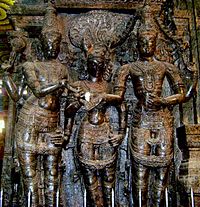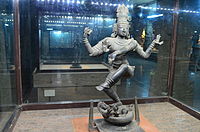 Meenakshi Amman Temple (also called: Meenakshi Sundareswarar Temple, Tiru-aalavaai and Meenakshi Amman Kovil) is a historic Hindu temple located on the southern bank of the Vaigai River in the temple city of Madurai, Tamil Nadu, India. It is dedicated to Parvati, known as Meenakshi, and her consort, Shiva, here named Sundareswarar. The temple forms the heart and lifeline of the 2,500 year old city of Madurai and is a significant symbol for the Tamil people, mentioned since antiquity in Tamil literature though the present structure was built between 1623 and 1655 CE. It houses 14 gopurams (gateway towers), ranging from 45–50m in height. The tallest is the southern tower, 51.9 metres (170 ft) high, and two golden sculptured vimanas, the shrines over the garbhagrihas (sanctums) of the main deities. The temple attracts 15,000 visitors a day, around 25,000 on Fridays, and receives an annual revenue of sixty million₹. There are an estimated 33,000 sculptures in the temple. It was on the list of top 30 nominees for the "New Seven Wonders of the World". The temple is the most prominent landmark and most visited tourist attraction in the city. The annual 10-day Meenakshi Tirukalyanam festival, celebrated during April and May, attracts 1 million visitors.
Meenakshi Amman Temple (also called: Meenakshi Sundareswarar Temple, Tiru-aalavaai and Meenakshi Amman Kovil) is a historic Hindu temple located on the southern bank of the Vaigai River in the temple city of Madurai, Tamil Nadu, India. It is dedicated to Parvati, known as Meenakshi, and her consort, Shiva, here named Sundareswarar. The temple forms the heart and lifeline of the 2,500 year old city of Madurai and is a significant symbol for the Tamil people, mentioned since antiquity in Tamil literature though the present structure was built between 1623 and 1655 CE. It houses 14 gopurams (gateway towers), ranging from 45–50m in height. The tallest is the southern tower, 51.9 metres (170 ft) high, and two golden sculptured vimanas, the shrines over the garbhagrihas (sanctums) of the main deities. The temple attracts 15,000 visitors a day, around 25,000 on Fridays, and receives an annual revenue of sixty million₹. There are an estimated 33,000 sculptures in the temple. It was on the list of top 30 nominees for the "New Seven Wonders of the World". The temple is the most prominent landmark and most visited tourist attraction in the city. The annual 10-day Meenakshi Tirukalyanam festival, celebrated during April and May, attracts 1 million visitors.
 Legend
Legend
Meenakshi is an avatar of the Hindu goddess Parvati - the consort of Shiva, one of the few Hindu female deities to have a major temple devoted to her. The name "Mīnachchi" means fish-eyed and is derived from the words "mīna" meaning fish and "akṣi" meaning eyes. The lady goddess Meenakshi is the principal deity of the temple, not Sundareswarar, unlike most Shiva temples in South India where Shiva is the principal deity. According to Hindu legend, in order to answer the prayers of the second Pandya king Malayadwaja Pandya and his wife Kanchanamalai, Parvati appeared out of the holy fire of the Putra Kameshti Yagna (sacrifice for childhood) performed by the king. According to another legend, the goddess herself gave notice to Kanchanamalai in one of her previous births that Kanchanamalai would have the privilege of mothering the goddess. The girl who came out of the holy fire had three breasts. A voice from the heavens told the king not to worry about the abnormality and added that the third breast would vanish as soon as the girl met her future husband. The happy king named the girl "Tadaatagai" and as the heir to the throne, Tadaatagai was trained carefully in all the 64 sastras, the fields of science.
As the time came for Tadaatagai's coronation, she had to wage war in three worlds encompassing eight directions. After conquering Brahma's Abode, Sathyaloka, Vishnu's Abode, Vaikunta, and Devas' abode Amaravati, she advanced to Shiva's Abode Kailasha. She very easily defeated the bhoota ganas and Nandi, the celestial bull of Shiva, and headed to attack and conquer Shiva. The moment she looked at Shiva, she was unable to fight and bowed her head down due to shyness, and the third breast vanished immediately. Tadaatagai realized that Shiva was her destined husband. She also realized that she was the incarnation of Parvati. Both Shiva and Tadaatagai returned to Madurai and the king arranged the coronation ceremony of his daughter, followed by her marriage with Shiva.
The marriage was to be the biggest event on earth, with the whole earth gathering near Madurai. Vishnu, the brother of Meenakshi, prepared to travel from his holy abode at Vaikuntam to preside over the marriage. Due to a divine play, he was tricked by the Deva, Indra and was delayed on the way. After the marriage, the pair ruled over Madurai for a long time and then assumed divine forms as Sundareswarar and Meenakshi, the presiding deities of the temple. Following the tradition, every evening, before closing the temple, a ritual procession led by drummers and a brass ensemble carries the image of Sundareswarar to Meenakshi's bedroom to consummate the union, to be taken back the next morning in dawn. The marriage is celebrated annually as Chithirai Thiruvizha in Madurai. During the period of Nayakar rule in Madurai, the ruler Thirumalai Nayakar linked the festival Azhakar Thiruvizha and the Meenakshi wedding ceremony.

Religious Significance of the Temple
A distinct feature of Meenakshi in terms of iconography is the presence of parrot in her right hand. The parrot is generally associated with the Vaishnava azhwar saint Andal."Pancha Sabhai" refers to the five royal courts of Nataraja (dancing form of Shiva) where he performed cosmic dance. The Tamil word velli means silver and ambalam means stage or altar. This massive Nataraja sculpture is enclosed in a huge silver altar and hence called "Velli Ambalam" (silver abode). This is a special figure of Natarja which usually differs from Chola bronzes; in the Chola images, Nataraja is shown dancing with his left leg raised, but this sculpture has the right leg raised. According to the Tiruvilayaadal Puranam (Shiva's sacred games), this is on the request of Rajasekara Pandya, who was a sincere devotee of Shiva. He requested the deity to change his position, as he felt that keeping the same foot raised would put enormous strain and got a graceful acquiescence from the divine master.
There are close to 50 priests in the temple who perform the puja (rituals) during festivals and on a daily basis. Like other Shiva temples of Tamil Nadu, the priests belong to Shivaite to the Adishaivas, a Brahmin sub-caste. The priests live in a closed area north of the temple. The temple has a six time pooja calendar everyday, each comprising four rituals namely abhisheka (sacred bath), alangaram (decoration), neivethanam (food offerings) and deepa aradanai (waving of lamps) for both Meenakshi and Sundareswarar. The puja (worship) ceremonies are held amidst music with nadhaswaram (pipe instrument) and tavil (percussion instrument), religious instructions in the Vedas by priests and prostration by worshippers in front of the temple mast. The common practise is to worship Meenakshi before Sundareswarar. Margazhi (December–January) ritual is prominent one for winning a perfect, god-like husband - it is Meenakshi's ennai kappu festival. Aligned with the cardinal points, the street plans forms a giant mandala (group) whose sacred properties are believed to be activated during the mass clockwise circumambulation of the central temple.